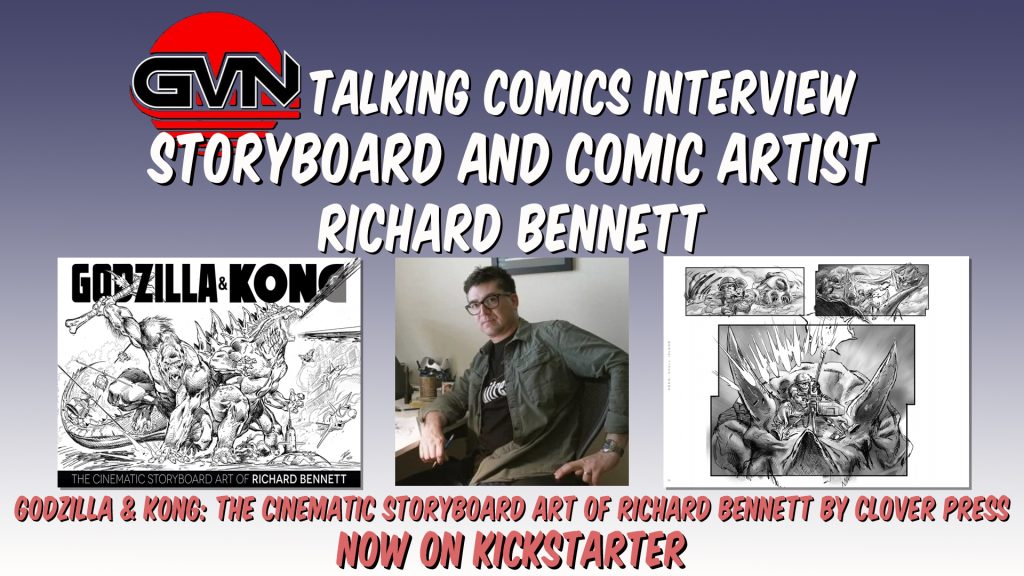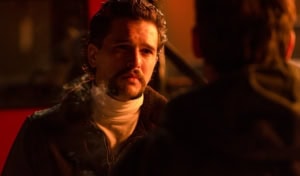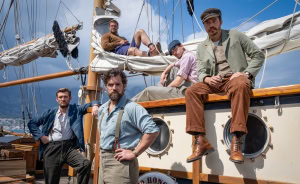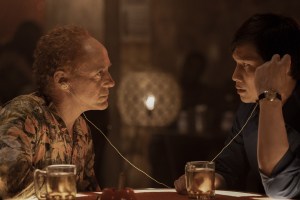Artist Richard Bennett had made a name for himself in the comic book field in the 90’s. Working with such comic icons as Neal Adams and Jim Lee. But as successful as his comic career has been, he had inspirations to work in film. Thus he used the skills he learned as a comic book artist and applied them to his next profession as film storyboard artist. He quickly became one of the most respected and utilized practioner of this art.
Richard has worked on some of the most popular and well received films in the last decade including Star Trek, Mission Impossible: Ghost Protocol, Avengers, Captain America: Winter Soldier, Captain America: Civil War and important in this context, Godzilla vs. Kong. In fact, he has a new book coming out through Clover Press centered on the work he did for the film. Godzilla & Kong: The Cinematic Storyboard Art of Richard Bennett comes to Kickstarter this week. So, with that in mind, we sat down with the talented artist and talked about his career in comics, film and his upcoming book. So, let’s welcome Richard Bennett to GVN’s Talking Comics.
Beginnings and Comics
GVN: Thank you so much for sharing a bit of your time, Richard. It is an honor to talk to you. So where to begin? You have compiled a diverse and impressive collection of work in both the comic world as well as television and film. When you first started in your art career, did you have such ambitions early on? Which type of art was your original goal and who were your inspirations at that time?
RB: I manifested the joy for drawing early on. By about 3 years old, I’d already started ruining my mother’s fashion magazines by drawing on the white margins. Around the same time I had a key experience seeing a Batman comic book at a general store. Years later I became aware about the artist, issue, etc. It was Neal Adams’ ’Detective Comics # 402’ and it features Batman in a swamp, holding an old oil lamp, with Manbat flying towards him, framed by a full moon on the background. It felt like a lighting bolt on my head, and there was no way I was going to leave the store without the book. My Mother got it for me, and obviously I couldn’t read the story, but from then on, I was hooked to the format.
When I was a teenager the idea of becoming a comic book artist started to gain momentum. I started studying art in a private academy, but the big change happened at age 17 when artist Eduardo Barreto offered me to help him out doing backgrounds on the ‘New Teen Titans’ series he was working for DC Comics at the time. In 1990 I moved to NY and landed my first gig with Neal Adams-Continuity Comics. I did all the artwork (over Neal’s layouts) on a new series named ‘CyberRad’.
From Comic to Film
The following decade would be all work in the comic book industry. After Continuity, I worked for Marvel on several of the X-Men books, then the longest period at Jim Lee’s Wildstorm where I co-created with Jim, the character ‘Brass’ for which I wrote the story and did all the artwork on the mini-series. While working in comics, it was always a long term goal to work in the film industry. Eventually that happened, but nevertheless, I credit in a big way my experience in the comic book field, and mentors I had while doing so, with giving me the skills that allowed the transition to film, once that opportunity presented itself.
This slideshow requires JavaScript.
Influence of Comics with Storyboarding
GVN: In a previous interview, you have mentioned that your comic book work has greatly influenced your storyboard work. How do you see those skills come into play as you work?
RB: Both the comic book field and storyboards in general have similar vernacular language. There are some differences, of course, particularly regarding the format or delivery. Comics are usually (with the exception of splash pages) divided into several panels per page. While storyboards are all drawn within the film’s ratio, with the ocasional extended frame that breaks out of that format.
Something to keep in mind also is that in comics, the ‘drawing’ is the final, end product. In storyboards, it’s a means to an end. That has an effect on how finished or detailed a comic book page is by comparison with a storyboard set of frames. Regardless, I like to produce rather detailed boards, and that could clearly be an influence of the comic book experience I had. I’d say the main factor influencing the work on storyboard would be storytelling. The choice of angles, dynamic, drawing in general evidently, all derives from comics, at least on my work.
Means to an End
There are changes that have to be made, in order to ‘translate’ some of that into the film language of course; yet they have a lot in common. It’s interesting because originally I wanted to do Concept Illustration for film, and once I had the chance to work on a film for the first time I really liked the idea of drawing storyboards.
On a curious note, when I drew ‘comics books’ as a child, I’d do it on a sketchpad, but I would not divide the page into several panels as it is done on a comic book in general. Instead, I’d draw one frame per page, and in my head I’d imagine those stories, as movies…So, they were more storyboards than actually comic books, but everything else, the way they were drawn, figures, drawing line, etc, emulated what I liked from comic books artists.
Collaborating with Directors
GVN: Since that time, you have worked on a huge number of popular films, including Star Trek, Mission Impossible: Ghost Protocol, Avengers, Captain America: Winter Soldier, Captain America: Civil War and Godzilla vs. Kong (just to name a few). With each project, what kind of time goes into the building of storyboards and how closely do you work with the film’s director or directors?
RB: I normally work very closely with the Director. The time always depends on any given project/film. The budget also has an effect on that. Scenes can have more exploration depending on the available budget. But that said, I’ve worked on all types. Big projects, independent ones. Big projects where I’d work in fewer scenes, but for a longer time with each; projects where I spent 8, 9 months doing a lot of scenes, etc.. It depends on the needs of the director.
Teamwork
GVN: Last year, I talked to Scanline VFX’s Bryan Hirota about Godzilla vs. Kong and their work (especially with “Old Man Kong”). As someone not familiar with how it works, does your storyboard work ever provide any insight into the work a VFX house might have to produce?
RB: What I’ve noticed through the years is that working on a film is one of the ultimate collaborative efforts. So, again, working with the director we might come up with ideas that later on are picked up by VFX and taken into a complete new level of ‘reality’. It’s a very organic process, with the Director always at the helm of it all, and the whole team contributing to the film.
This slideshow requires JavaScript.
Godzilla & Kong: The Cinematic Storyboard Art of Richard Bennett
GVN: Speaking of your work on Godzilla vs Kong, you are producing a highly anticipated book of your work on the film, Godzilla & Kong: The Cinematic Storyboard Art of Richard Bennett by Clover Press. I love these kinds of books, detailing the process and what goes into creating these pictorial film scripts. How long has this particular book been in the works?
RB: I had the idea of putting together a book compiling some of my work for some years now. In 2019 I was talking with my friend and colleague Dwayne Turner, and he mentioned back then about Clover Press. I knew all the Clover Press guys from Wildstorm (back in the 90’s) but wasn’t up to date with what they were doing at the time. I got in touch immediately with them, pitched the idea, and they loved it. The way in which they are putting this together exceeded all my expectations so I’m really excited about the upcoming book.
Kickstarter
GVN: It sounds like it will be a fantastic book and is coming to Kickstarter (I foresee another book purchase). How has that experience been and what kind of things will a fan of your work find when they check out your campaign?
RB: Like I said the experience of making the book a reality has been awesome. Robbie Robbins is designing the book, I had the prior experience of working with him on my series ‘Brass’ back in comics, so I was hoping he would be interested in designing the book. I had a preview of some pages and I’m really happy and proud. My thought/rule of thumb back when I did comics was always to draw something that I’d want to buy at the comic book store’. I can assure you I’d definitely want to get this book if I was a fan. Not only a fan of the main characters but film in general.
It’ll give the reader a chance to look at the planning during the pre-production phase of the films. They’ll be able to match scenes to the shot, from the big screen. As well as getting an insight on some of the unused scenes as well. Fans will also be able to get several extras with the edition.
Following Richard
GVN: I really look forward to adding it to my collection. Thank you once again for your time, Richard. Before I let you go, where can our followers go to follow your work on either social media or the web?
RB: Thank you so much for your interest in my work. They can look at more work (both film and comic books) on Instagram: richardbennett_storyboards
Godzilla & Kong: The Cinematic Storyboard Art of Richard Bennett by Clover Press comes to Kickstarter this week. You can check out this exciting look into the behind the scenes planning of Godzilla vs. Kong from one of the masters of the artform here.
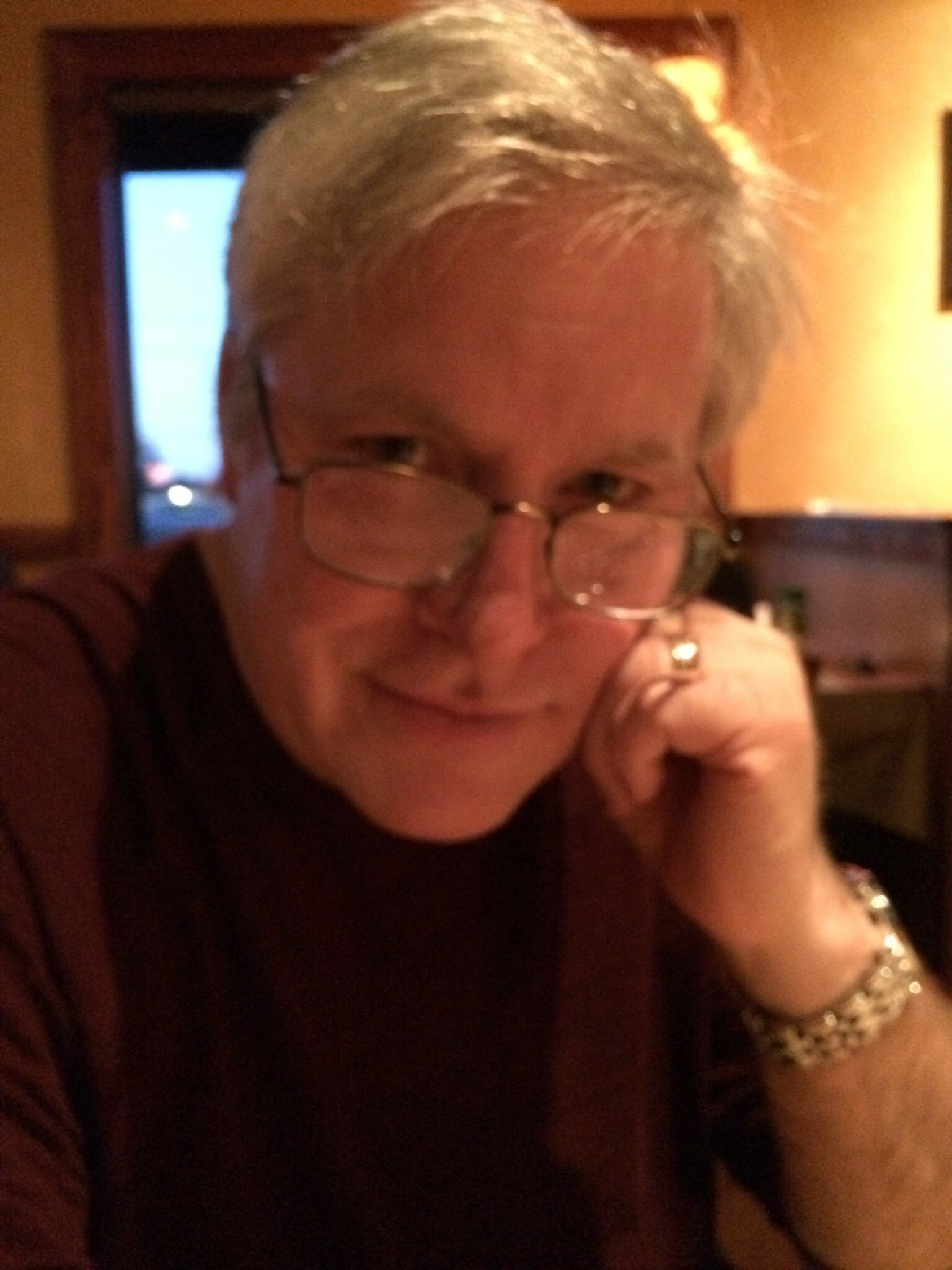
Senior Writer at GeekVibesNation – I am a 50 something child of the 70’s who admits to being a Star Trek/Star Wars/Comic Book junkie who once dove head first over a cliff (Ok, it was a small hill) to try to rescue his Fantastic Four comic from a watery grave. I am married to a lovely woman who is as crazy as I am and the proud parent of a 18 year old boy with autism. My wife and son are my real heroes.


